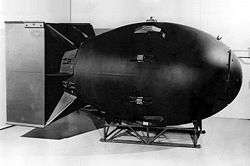Launch on warning
| Nuclear weapons |
|---|
 |
| Background |
| Nuclear-armed states |
|
Launch on warning (LOW) is a strategy of nuclear weapon retaliation that gained recognition during the Cold War between the United States and the Soviet Union. With the invention of intercontinental ballistic missiles (ICBMs), launch on warning became an integral part of mutually assured destruction (MAD) theory. Under the strategy, a retaliatory strike is launched upon warning of enemy nuclear attack while its missiles are still in the air and before detonation occurs.
History
Before the introduction of intercontinental ballistic missiles (ICBMs), the U.S. Strategic Air Command had multiple bombers on patrol at all times[1] like, presumably, its Soviet counterpart. In the event of a nuclear strike by one of the nations, the other nation would order its bombers to fly to the other country and drop their nuclear payload on predetermined targets. In the United States, the bombers were typically either B-47 Stratojets or B-52 Stratofortresses, and there were three major flight routes. Keeping bombers in the air assured that a second strike would be feasible even if the first strike were to impair ground facilities. At the height of the Cold War, the United States had special Boeing EC-135 "Looking Glass" aircraft equipped as control centers for the nuclear arsenal. The battle staff included a general or flag officer who was authorized to order a retaliatory strike if the President could not be contacted.[2]
Launch on warning has its roots in US President Dwight Eisenhower's "Positive Control" strategy but really took shape with the introduction of the Minuteman missile. Since many ICBMs (including the Minuteman) were launched from underground silos, the concern arose that a first strike, by one nation, could destroy the ground launch facilities of the retaliating nation.
In 1997, the Clinton administration changed the official policy away from launch on warning to one of retaliation after withstanding an initial first strike.[3]
The introduction of nuclear-tipped ICBMs required new strategies because unlike bombers, ICBMs cannot be recalled after launch. There were two primary options. One option, "retaliation after ride-out", required the second-strike nation to wait until after it was attacked to launch their missiles. Some portion of the nuclear arsenal would inevitably be destroyed in such an attack, which led to both superpowers investing heavily in survivable basing modes[4] for their nuclear forces, including hardened underground missile silos for ICBMs,[5] and submarine-launched ballistic missiles. The other choice was "launch on warning", launching nuclear missiles before the other side's missiles could destroy them. That became possible primarily because of improvements in missile technology that allowed for faster launches,[6] along with invention of the Ballistic Missile Early Warning System in the early 1960s, which made it possible for the US to detect the launch of Soviet missiles. The capability was further enhanced in the 1970s with the deployment of space-based launch detection technology on both sides, the American geosynchronous Defense Support Program and Soviet Oko satellites. Evidence found in declassified documents suggests that launch on warning was at least in part the policy of the United States from the late 1950s through to at least the 1970s.[6]
Strategies are available that can reduce the effectiveness of a launch-on-warning stance. For example, the first-strike nation can use a technique called X-ray pin-down to delay a retaliatory response. It involves a barrage of submarine-based missiles fired from close range in a "depressed trajectory" mode that reaches its targets in minutes. The warheads would be set to explode every minute or so at high altitudes, which significantly disrupts the ability of the attacked nation to launch its own ICBMs.[7] Additionally, submarines could launch a depressed-trajectory strike against the capital of the targeted country in an effort to destroy its command structure before any retaliatory decision could be made; that is known as a decapitation strike.
The deployment of submarine-launched ballistic missiles (SLBMs) decreases the strategic need for a launch-on-warning strategy. These submarines are capable of hiding in the ocean during an attack, thus ensuring that a second strike can be made even if the attacked country is unable to launch a land-based counterstrike.
See also
- Bulletin of the Atomic Scientists
- DEFCON
- Deterrence theory
- Doomsday clock
- Fail-deadly
- Game theory
- Mutually assured destruction
- Nash equilibrium
- Stanislav Petrov
References
- ↑ Globalsecurity.org, Strategic Air Command. Accessed 23 February 2001
- ↑ https://fas.org/programs/ssp/man/uswpns/air/special/ec135.html
- ↑ Cerniello, Craig (November–December 1997). "Clinton Issues New Guidelines on U.S. Nuclear Weapons Doctrine". Arms Control Today. Arms Control Association. Retrieved 11 January 2014.
- ↑ Launch on Warning: A Counter to the Arms Race
- ↑ Insuring Survivability: Basing the MX Missile
- 1 2 Burr, William (April 2001). "Launch on Warning: The Development of U.S. Capabilities, 1959-1979". The National Security Archive. Retrieved 24 February 2011.
- ↑ John Steinbruner, "Launch under Attack", Scientific American, January 1984, pp. 37–47